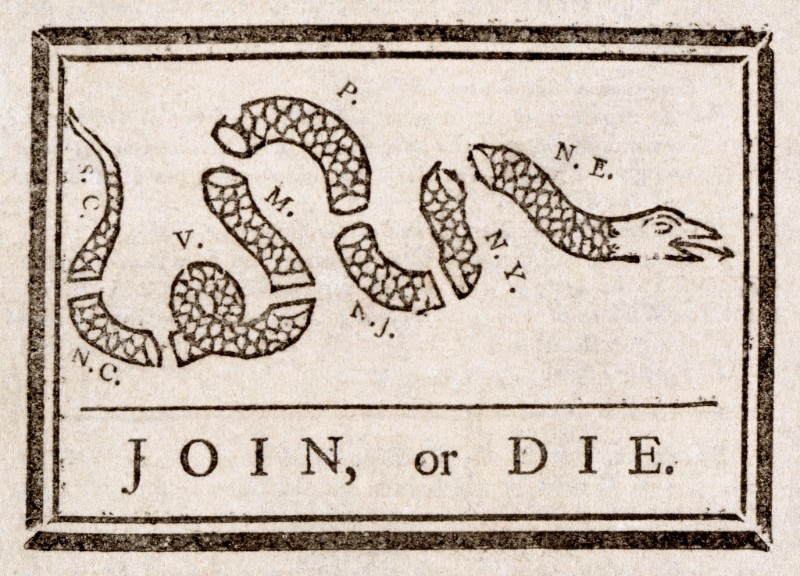
In 1751 Benjamin Franklin wrote a commentary in his Pennsylvania Gazette suggesting a way to thank the Brits for their policy of sending convicted felons to America – the colonists should send rattlesnakes to England!
Three years later, Franklin created and published the first known political cartoon in an American newspaper. It was the image of a snake cut into eight sections, representing the colonies and coastline. Written under the snake were words of warning: “Join, or Die.”
This was not a reference to independence, but a plea for unity in defending the colonies during the French and Indian War. There was a superstition that if a snake was cut into pieces it could come back to life if you joined the sections together before sunset.
So, from then on, Franklin’s snake “wriggled” its way into American culture as an early symbol of a national identity.
Congress formed a plan to to get the cargo into the hands of General Washington. So, Congress gave birth to Continental Navy with its first four ships. Congress then authorized the mustering of five companies of Marines. Some of those Marines were carrying drums painted yellow, decorated with a fierce rattlesnake, coiled and ready to strike, with thirteen rattles, and sporting the motto “Don’t Tread on Me.”
In December “An American Guesser” (really Benjamin Franklin) anonymously wrote to the Pennsylvania Journal:
“I observed on one of the drums belonging to the marines now raising, there was painted a Rattle-Snake, with this modest motto under it, ‘Don’t tread on me.’ As I know it is the custom to have some device on the arms of every country, I supposed this may have been intended for the arms of America.”
Benjamin speculated on why a snake is a symbol for America:
“The Rattle-Snake is found in no other quarter of the world besides America.”
The rattlesnake also has sharp eyes, and “may therefore be esteemed an emblem of vigilance.”
“She never begins an attack, nor, when once engaged, ever surrenders: She is therefore an emblem of magnanimity and true courage. … she never wounds ’till she has generously given notice, even to her enemy, and cautioned him against the danger of treading on her.”
And finally he writes:
“I confess I was wholly at a loss what to make of the rattles, ’till I went back and counted them and found them just thirteen, exactly the number of the Colonies united in America; and I recollected too that this was the only part of the Snake which increased in numbers. …
“‘Tis curious and amazing to observe how distinct and independent of each other the rattles of this animal are, and yet how firmly they are united together, so as never to be separated but by breaking them to pieces. One of those rattles singly, is incapable of producing sound, but the ringing of thirteen together, is sufficient to alarm the boldest man living.”
So, Franklin helped created the American rattlesnake symbol, but why isn’t his name attached to it? How did this yellow standard become commonly known as the Gadsden flag (or Hopkins flag)?
Christopher Gadsden, an American patriot leader of the Sons of Liberty since 1765, and Congress chose Commodore Esek Hopkins, as the commander-in-chief of the Navy.
Gadsden presented to Congress the standard to be used by the commander. I had the yellow field, with a representation of a rattle-snake in the middle, about to strike,with the words underneath “Don’t Tread on Me!”
So, the flag, became known as the “Gadsden flag.” This and other rattlesnake flags were widely used during the American Revolution.
After the Revolution, the rattlesnake flags became less common. General Washington and Congress preferred stars, stripes, and the more “conventional” symbols, like the American bald eagle.
Whatever your call it, the Gadsden flag remains a popular symbol for keeping alive and celebrating that spirit of July 4, 1776. And it would be totally okay if you were to display this flag on any day!




More Stories
US Supreme Court Reasserts Gun Rights
6 Things You Didn’t Know About Canada
Conway Cabal: The Plot to Remove Washington